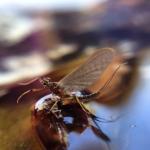This series of lessons explores the identification, classification and feeding relationships of organisms, using local waterbugs (aquatic macroinvertebrates) – key indicators of waterway health.
Students classify waterbugs by their observable structural features and investigate the biodiversity of local freshwater environments. They develop a dichotomous key using their own criteria for classifying macroinvertebrates and consider how biologists use keys in their field work. They use their understanding about the types of waterbugs to create a food web for their local waterway.
Students should ideally experience macroinvertebrate monitoring activities in the field, as part of a field excursion to a local waterway. However, students can also sort and identify the organisms in the classroom by having a macroinvertebrate sample collected on the morning of the lesson. For details, refer to the Teacher guide: Running a waterbug session with students.
Download the lesson plan
This lesson plan contains modules explicitly linked to the Victorian Curriculum.
Activities
Activity 1: Identifying waterbugs
Students identify waterbugs in a water sample, and consider how these organisms can be used to indicate the ecological health of a waterway using the sensitivity scores of each species. This activity is most effective when conducted as a field excursion, but can also be done in the classroom if a waterbug sample is collected early on the same day.
Activity 2: Classifying waterbugs
Students explore how biologists use classification levels and dichotomous keys to identify species using waterbugs.
Activity 3: Waterbug food webs
Students explore the feeding relationships of waterbugs and other organisms in the Maribyrnong River. They devise a food web using data from their local waterway, and discuss the impact of human activity on the ecology of the river.
Victorian curriculum
- VCSSU090: Science and technology contribute to finding solutions to a range of contemporary issues; these solutions may impact on other areas of society and involve ethical considerations
Science > Science understanding > Science as a human endeavour - VCSSU091: There are differences within and between groups of organisms; classification helps organise this diversity
Science > Science understanding > Biological sciences - VCSSU093: Interactions between organisms can be described in terms of food chains and food webs and can be affected by human activity
Science > Science understanding > Biological sciences
Resources
Waterbug census
Waterbugs let us know how healthy our water is, and you can too. By joining the Waterbug Census and monitoring your local macroinvertebrates, you’ll help us check the health of our rivers and creeks.

